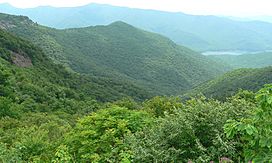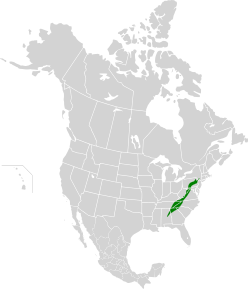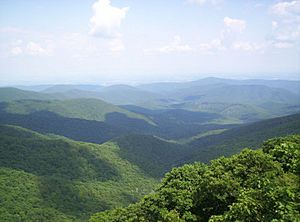Appalachian–Blue Ridge forests facts for kids
Quick facts for kids Appalachian–Blue Ridge forests |
|
|---|---|

View from the Blue Ridge Parkway in North Carolina
|
|
 |
|
| Ecology | |
| Realm | Nearctic |
| Biome | Temperate broadleaf and mixed forests |
| Borders | Northeastern coastal forests, Allegheny Highlands forests, Appalachian mixed mesophytic forests and Southeastern mixed forests |
| Bird species | 194 |
| Mammal species | 73 |
| Geography | |
| Area | 159,300 km2 (61,500 sq mi) |
| Country | United States |
| States | |
| Conservation | |
| Habitat loss | 27.1% |
| Protected | 18.6% |
The Appalachian–Blue Ridge forests are a special natural area in the Eastern United States. They are part of the Temperate broadleaf and mixed forests Biome. This means they are forests with many trees that lose their leaves in the fall.
You can find these forests in the central and southern parts of the Appalachian Mountains. This includes the Ridge-and-Valley Appalachians and the Blue Ridge Mountains. The area covers about 159,300 square kilometers (61,500 square miles). It stretches across many states, like Alabama, Georgia, South Carolina, Tennessee, North Carolina, Virginia, Maryland, West Virginia, and Pennsylvania. Small parts also reach into Kentucky, New Jersey, and New York.
These forests are among the richest in the world for their plant and animal life. They have an amazing number of different species. Many of these species are endemic, meaning they are found nowhere else. This is because the region has been stable for a long time. Its long ridges and valleys act like natural pathways or barriers. This helped habitats move during ice ages. The mountains also have many different landscapes and small climates. This allows many unique plants and animals to survive and thrive.
Contents
- What is the Climate Like?
- Amazing Plant Life
- Different Types of Forests
- Cove Forests
- Low-Elevation Pine Forests
- Oak Forests
- Dry Calcareous Forests
- Dry Oak Forests and Woodlands
- Dry Oak–Pine Forests
- Dry–Mesic Oak Forests
- Pine-Oak Rocky Woodlands
- Montane Oak Forests
- Montane Pine Forests and Woodlands
- Northern Hardwood Forests
- Hemlock–Northern Hardwood Forests
- Spruce-Fir Forests
- Balds
- Bogs
- Sods
- Different Types of Forests
- Amazing Animal Life
- What Threats Do These Forests Face?
- Protected Areas of Forest
What is the Climate Like?
The weather in these forests changes from north to south. In the north, it's a humid continental climate. This means cold winters and warm summers. In the south, it's a humid subtropical climate. This means mild winters and hot, humid summers.
Summers are hot in lower areas and warm in higher areas. Winters are cold in higher areas and cool in lower areas.
Amazing Plant Life
The Appalachian forests are incredibly rich in plant life. Only a few other places in the world, like parts of China and Japan, have similar forests. The Appalachians and central China share plants from an ancient forest. This forest once covered much of the Northern Hemisphere. You can find certain plant genera (groups of species) and families (larger groups) only in these two places. The Great Smoky Mountains are especially rich in different kinds of plants.
The Appalachians are home to 158 different kinds of trees. This is more than anywhere else in North America! There are two main types of forests here:
- Deciduous oak forests grow at lower elevations (between 250m and 1350m). These trees lose their leaves each fall.
- Coniferous spruce-fir forests grow higher up. These trees have needles and cones, like Christmas trees.
Until the 1930s, the oak forests also had many American chestnut trees. But a fungus called chestnut blight wiped out most of them.
Different Types of Forests
The Appalachian forests have many different kinds of smaller forest areas. Each one has its own special mix of trees and plants.
Cove Forests
These forests grow in sheltered areas called "coves." They are found on slopes that face north or east. They are some of the most diverse ecosystems in the country. Common trees include sugar maple, American beech, eastern hemlock, and tulip poplar.
Low-Elevation Pine Forests
You can find these forests on ridges, slopes, and in lower valleys. They are mostly made up of shortleaf pine and Virginia pine trees. You might also see some oak trees mixed in.
Oak Forests
These forests are common on dry, high areas and sunny slopes. They are filled with different kinds of oak trees, like chestnut oak, northern red oak, and white oak. You can also find hickory trees here.
Dry Calcareous Forests
These forests grow on dry, rocky ground that has a lot of calcium. They are found in the southern Ridge-and-Valley Appalachians. White oak, northern red oak, and shagbark hickory are common trees here.
Dry Oak Forests and Woodlands
These forests are found on ridges in the southern Ridge-and-Valley Appalachians. They are mostly made of white oak, southern red oak, and chestnut oak. You might also see some red maple and hickory trees.

Dry Oak–Pine Forests
These forests grow in dry areas with sandy soil. They have a mix of oak and pine trees. Common trees include chestnut oak, Virginia pine, and white pine.
Dry–Mesic Oak Forests
These forests cover large areas at lower and middle elevations. They are found on flat or gently rolling land. Red oak, white oak, and black oak are common here. Other trees include hickories, red maple, and American beech.
Pine-Oak Rocky Woodlands
These woodlands are found on hilltops, rocky slopes, and outcrops at lower elevations. They often look patchy or open. Pitch pine and Virginia pine are common. They are often mixed with dry-site oaks like chestnut oak and scarlet oak.
Montane Oak Forests
These forests are on exposed ridges and south- or west-facing slopes at middle elevations. The soil is thin and not very rich. Trees here are often small and shaped by the wind. Northern red oak and white oak are common.
Montane Pine Forests and Woodlands
These forests are found on exposed ridges, clifftops, and sunny slopes. They grow at elevations between 450 and 1200 meters (1,500 to 4,000 feet). The ground is often rocky and the soil is shallow and dry. These areas are very likely to catch fire. They are mostly covered by table mountain pine, often with pitch pine or Virginia pine.
Northern Hardwood Forests
These forests grow in cool, moist areas above 1,370 meters (4,500 feet) in the southern Appalachians. Sugar maple, beech, yellow birch, and yellow buckeye are common trees. Sometimes, you'll also find eastern hemlock and red spruce.
Hemlock–Northern Hardwood Forests
These forests are found in deep coves and moist ravines. They stretch from Virginia and West Virginia northward. Yellow birch, mountain maple, sugar maple, and beech are common. They are sometimes joined by hemlock or white pine.
Spruce-Fir Forests
These special forests are found only on the highest peaks and ridges. The soil is poor, and the growing season is short. They get moisture from rain, snow, and fog. Red spruce, Fraser fir, yellow birch, and mountain ash are common trees here.
Balds
Appalachian balds are areas on high mountain tops and slopes. They are covered by native grasses or thick shrubs instead of trees.
Bogs
Appalachian bogs are like northern wetlands. They are found in many parts of the Appalachians, especially in the Allegheny and Blue Ridge areas. Even though they are called bogs, many are actually fens, which get water from groundwater.
Sods
"Sods" is a term used in West Virginia for a mountaintop meadow or bog. These areas are usually surrounded by forests. They are similar to Appalachian balds.
Amazing Animal Life
The Appalachian forests are home to many animals, including some rare ones. Some endangered or threatened species include certain snails and salamanders. You might also find the red-shouldered hawk, loggerhead shrike, and the Virginia big-eared bat. The red wolf and the spruce-fir moss spider also live here.
The limestone caves in the Appalachians are very important for bats, invertebrates (animals without backbones), fish, and salamanders. These caves are home to 34 species of lungless salamander, which is more than anywhere else on Earth!
What Threats Do These Forests Face?
Humans have changed these forests a lot. People have cut down trees for logging and cleared land for farms, cities, and mining. Only small parts of the original forest remain. The largest untouched area is in the Great Smoky Mountains. For example, nearly all of Shenandoah National Park is forest that has grown back. But it is still very important for wildlife.
The spruce and fir forests in the high mountains have been cut down a lot. In many places, they haven't grown back. This has left areas of Appalachian balds (open, grassy areas). Also, large predators like wolves and cougars have been removed. This means there are too many deer, which eat too many plants.
New species that are not native to the area also threaten the plants and animals. These include the gypsy moth, spruce budworm, and hemlock woolly adelgid. There is also a disease called Discula destructiva that harms dogwood trees. It is similar to the chestnut blight that wiped out the American chestnut.
Protected Areas of Forest
Many parts of these forests are now protected. Most of these areas are owned by the public. Here are some of them:
- Alabama
- Talladega National Forest
- Dugger Mountain Wilderness
- Mountain Longleaf National Wildlife Refuge
- The Indian Mountain Tract
- Little River Canyon National Preserve
- Talladega National Forest
- Georgia
- Crockford-Pigeon Mountain Wildlife Management Area
- Chattahoochee National Forest
- Blood Mountain Wilderness
- Raven Cliffs Wilderness
- Mark Trail Wilderness
- Southern Nantahala Wilderness
- Ellicott Rock Wilderness
- Big Frog Wilderness
- Brasstown Wilderness
- Tray Mountain Wilderness
- Cohutta Wilderness
- Rich Mountain Wilderness
- South Carolina
- Gorges State Park
- Mountain Bridge Wilderness Area
- Sumter National Forest
- Ellicott Rock Wilderness
- North Carolina
- DuPont State Forest
- Pisgah National Forest
- Shining Rock Wilderness
- Middle Prong Wilderness
- Linville Gorge Wilderness
- Nantahala National Forest
- Ellicott Rock Wilderness
- Joyce Kilmer-Slickrock Wilderness
- Cherokee National Forest
- Great Smoky Mountains National Park
- South Mountains State Park
- Tennessee
- Great Smoky Mountains National Park
- Cherokee National Forest
- Little Frog Wilderness
- Big Frog Wilderness
- Cohutta Wilderness
- Gee Creek Wilderness
- Bald River Gorge Wilderness
- Citico Creek Wilderness
- Joyce Kilmer-Slickrock Wilderness
- Sampson Mountain Wilderness
- Unaka Mountain Wilderness
- Pond Mountain Wilderness
- Big Laurel Branch Wilderness
- Virginia
- George Washington and Jefferson National Forests
- Ramsey's Draft Wilderness
- Rough Mountain Wilderness
- Rich Hole Wilderness
- Saint Mary's Wilderness
- Priest Wilderness
- Three Ridges Wilderness
- James River Face Wilderness
- Shawvers Run Wilderness
- Peters Mountain Wilderness
- Mountain Lake Wilderness
- Brush Mountain East Wilderness
- Brush Mountain Wilderness
- Hunting Camp Creek Wilderness
- Garden Mountain Wilderness
- Beartown Wilderness
- Little Dry Run Wilderness
- Raccoon Branch Wilderness
- Little Wilson Creek Wilderness
- Lewis Fork Wilderness
- Clinch Mountain Wildlife Management Area
- Hidden Valley Wildlife Management Area
- Nathaniel Mountain Wildlife Management Area
- Sleepy Creek Wildlife Management Area
- Shenandoah National Park
- Indian Springs Wildlife Management Area
- George Washington and Jefferson National Forests
- West Virginia
- Monongahela National Forest
- Laurel Fork North Wilderness
- Laurel Fork South Wilderness
- Spice Run Wilderness
- Big Draft Wilderness
- Monongahela National Forest
- Maryland
- Savage River State Forest
- Green Ridge State Forest
- Pennsylvania
- New Jersey
- Delaware Water Gap National Recreation Area
- Bear Swamp Wildlife Management Area
- Worthington State Forest
- Wallkill River National Wildlife Refuge
- New York
- Highland Lakes State Park
- Stewart State Forest













